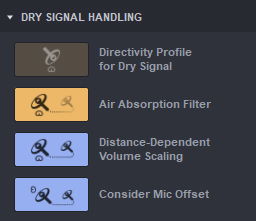Actually things are quite straight-forward - you just confused yourself a bit, it seems. 😊
Quoting the manual -> https://www.vsl.info/en/manuals/mir-pro-3d/instrument-settings
Dry/Wet determines the ratio of dry and wet signals for the channel. When MIR Pro 3D is in “Classic Mode” and “Distance Dependent Scaling” of the dry signal is On, the default value at the center position should roughly match the signal’s natural sonic impression in that Venue. [...]Important
“100% wet” is NOT the sound you would hear in the Venue, as all impulse responses used in MIR Pro 3D had their initial direct signal removed in order to avoid ugly phasing artifacts. In other words: MIR Pro 3D expects some dry signal component mixed in to sound “natural”!
If you don't like the positioned dry signals mixed in, you can simply go "all wet", but it will sound unnatural. If you don't like the the distance dependent volume scaling of the dry signal, simply switch it off:
-> https://www.vsl.info/en/manuals/mir-pro-3d/instrument-settings#dry-signal-handling
... you can also switch MIR 3D to "Pop Mode", if you want to de-activate the dry signal's scaling for all Icons.
-> https://www.vsl.info/en/manuals/mir-pro-3d/venue-handling
The formula MIR uses for scaling is not the scientific -6dB with each doubling of the distance. This works in the free-field only. MIR takes into account that we always are in an fully enclosed hall by definition, so it's only -3dB for each doubling (which feels more comfortable for our needs).
BTW: There is no distance scaling for the wet signal - this happens all by itself (... the natural volume relation of the IRs is preserved throughout a complete MIR Venue).
If you really think that it's necessary to implement a delay between dry and wet signal you will need the routing options MIR 3D has in VE Pro only. Here you could route the wet signal to a different bus and add some delay there:
... my personal expectation is that the sound you'll achieve like that will be - uhm ... interesting, but most certainly not natural. 8-)
One IMPORTANT FINAL NOTE: If you use 3rd order capsule-based Ambisonics formats for the output of the MIR 3D, you will be confronted with rather strange pickup patterns when you go to the extremes (see below). This will of course have a wicked effect on the perceived behaviour of the dry signals when changing positions in relation to the main microphone!
Kind regards,
/Dietz - Vienna Symphonic Library
